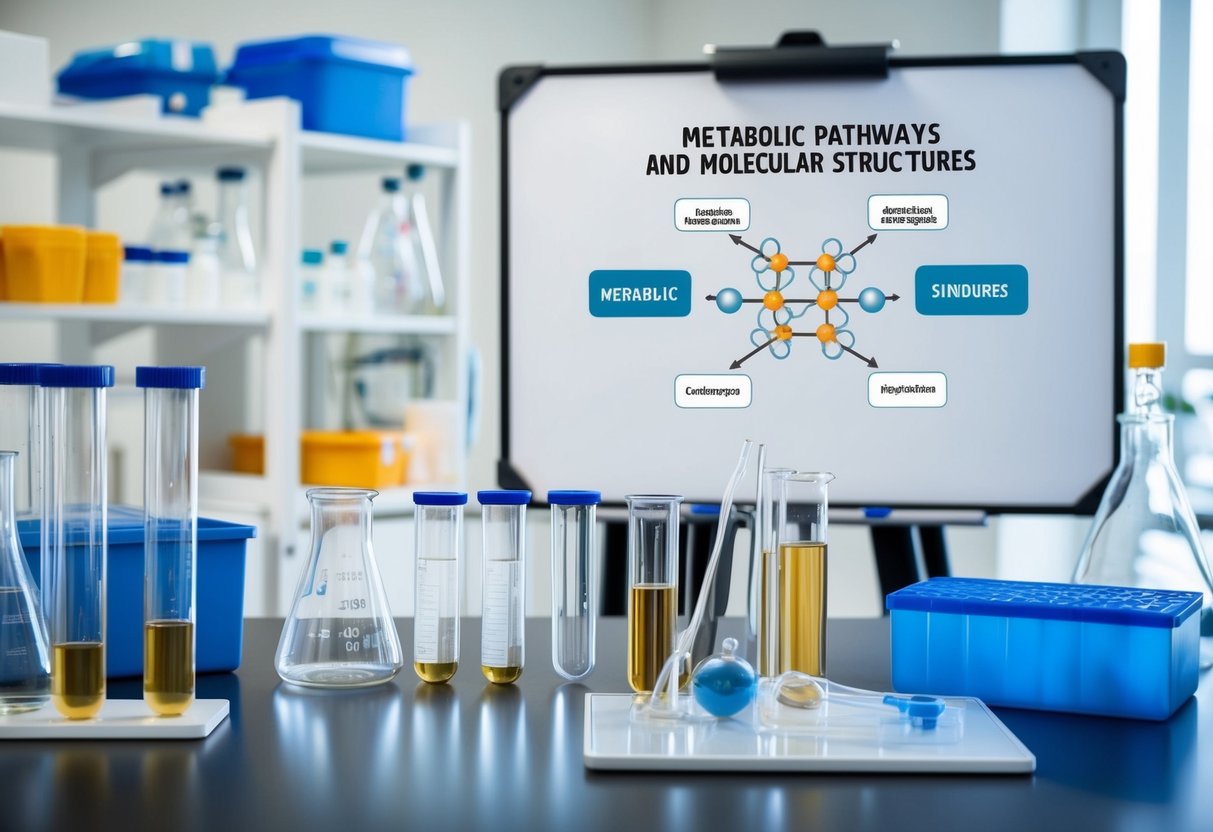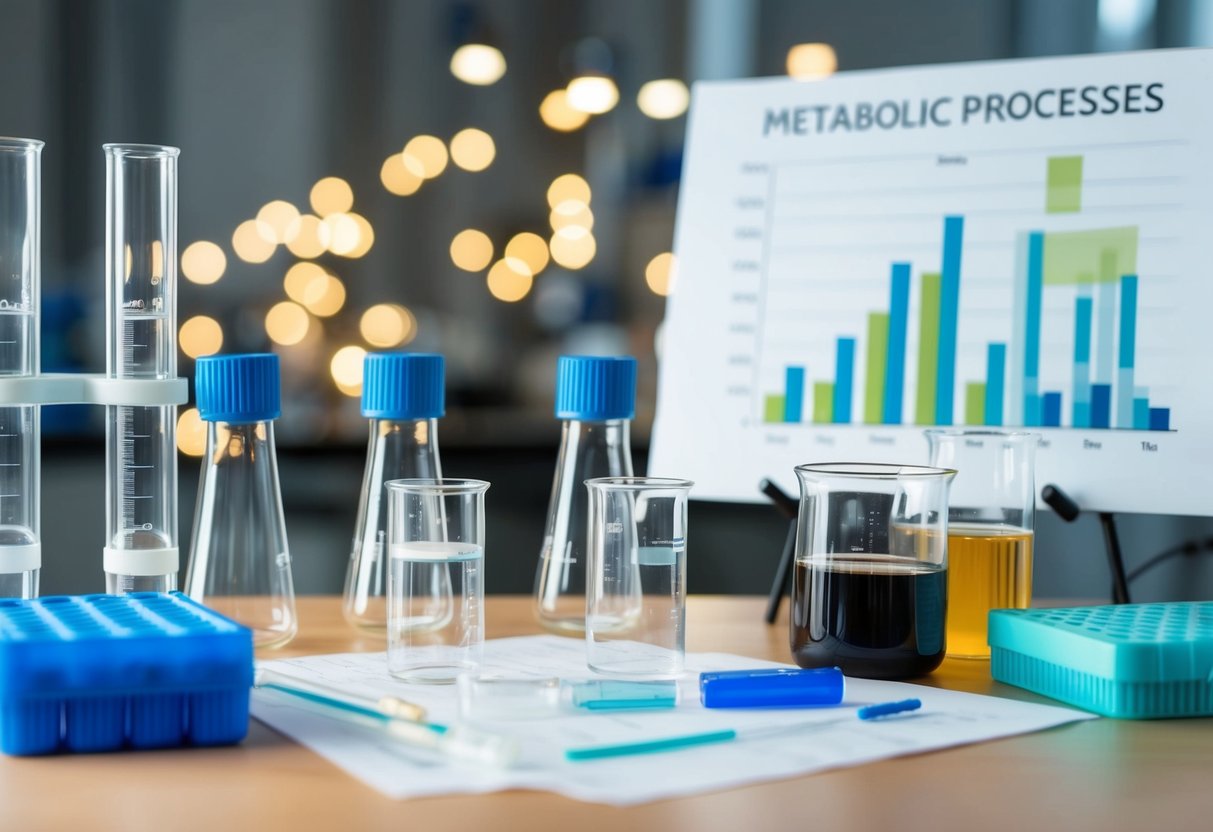The Science of Ketosis: Exploring Metabolic Adaptation
This post may contain affiliate links. If you purchase through these links, I may earn a small commission at no extra cost to you. LEARN MORE.
The world of nutrition and health has seen a growing interest in the ketogenic diet, a high-fat, low-carbohydrate plan that shifts the body into ketosis. In this state, the body begins to burn fat for fuel instead of carbohydrates.

The science behind ketosis and metabolic adaptation offers insights into how the body adapts to a keto diet. The process affects energy expenditure, fat burning, and overall metabolic health.
When carbohydrates are reduced, the body transitions to a state where fat and ketones become the primary sources of energy, potentially offering benefits in terms of weight management and metabolic health.
Understanding ketosis and how it influences metabolism is key to optimizing health and achieving various fitness goals.
New to keto? Begin with our Keto Diet for Beginners: Easy Tips to Kickstart Your Journey for a solid start.
Unlock personalized insights with our Custom Keto Diet program and master your metabolism!
Key Takeaways
- Ketosis changes how the body uses fat and carbohydrates.
- Metabolic adaptation can improve energy use and health.
- Nutrition and exercise impact the success of keto diets.
Understanding Ketosis

Ketosis is a metabolic state that involves an increase in ketone bodies in the blood. This occurs when the body uses fat as its primary energy source instead of carbohydrates. Ketones are the byproducts of fat breakdown and play a crucial role in energy metabolism.
Defining Ketosis
Ketosis is achieved when the body doesn’t have enough glucose for energy, prompting it to burn stored fats instead. This metabolic shift results in elevated levels of ketone bodies.
Ketone bodies are produced in the liver and include molecules like beta-hydroxybutyrate (βHB), acetoacetate, and acetone.
This state is often the goal of low-carbohydrate diets such as the ketogenic diet. Unlike starvation, ketosis allows for energy production and maintenance of vital body functions through fat metabolism.
Learn more about ketosis fundamentals in our How to Calculate Macros for Keto: Step-by-Step guide
The Role of Ketones
Ketones act as signaling molecules that impact metabolism and brain function. They help regulate energy homeostasis, influencing hunger and satiety.
In the brain, ketones provide an efficient and stable energy source, which can enhance cognitive function.
Ketones might also play a part in protecting neurons and may have therapeutic potential in certain neurological disorders.
The body’s production of ketones indicates efficient energy usage, reflecting adaptive responses to carbohydrate restriction.
Discover the benefits of ketones in our Keto & Gut Health: Unlock Microbiome Secrets post.
Nutritional Ketosis vs. Ketoacidosis
Nutritional ketosis is a controlled and safe metabolic state resulting from a carbohydrate-restricted diet. It involves moderate levels of ketones, which provide a consistent energy source without adverse effects.
In contrast, ketoacidosis is a potentially dangerous condition marked by excessive ketone accumulation, leading to dangerously low blood pH levels. This is most often associated with conditions like unmanaged diabetes.
It’s important to distinguish between these states, as they differ greatly in terms of health and safety. Nutritional ketosis is beneficial and part of a deliberate dietary strategy, whereas ketoacidosis requires medical intervention.
The Science of Ketosis

The science behind keto diets emphasizes specific macronutrient ratios to encourage a state called ketosis. This section explores how an increased intake of fats, coupled with reduced carbohydrates, can provide various benefits, such as weight loss and mental clarity. Addressing common misconceptions is crucial for understanding the true impact of these diets.
Macronutrient Ratios
Ketogenic diets focus on a high-fat, low-carbohydrate approach. Typically, dietary intake includes around 70-75% fats, 20-25% proteins, and only 5-10% carbohydrates.
Fats serve as the primary energy source, replacing glucose, which the body normally uses.
By limiting carbohydrates drastically, the body enters a state of ketosis, where it burns fat for energy.
Proteins are moderated to prevent disruption of ketosis. Fiber is important, even in low-carb diets, to support digestive health.
Master your macros with our The Ultimate Custom Keto Diet Review for perfect balance.
Ketogenic Diet Benefits
Keto diets are popular for their potential benefits. Many people experience significant weight loss, primarily due to the body’s shift in energy source.
There’s evidence suggesting improved mental clarity and focus. Ketones, produced during ketosis, may have protective effects on brain health.
Metabolic health sees enhancement as well; some individuals notice better insulin sensitivity and decreased blood sugar levels.
Read more on metabolic health in our Keto for Immune Health: Enhance Defenses Through Diet article.
Common Misconceptions
Many misconceptions surround keto diets. One is that they involve cutting all carbohydrates completely. Rather, the diet emphasizes low-carb choices and restricts high-carb foods.
Another myth is that it consists solely of eating greasy, unhealthy foods. In reality, healthy fats like avocados, nuts, and olive oil are staples.
Some believe keto means complete avoidance of fiber. In fact, fibrous vegetables are encouraged to maintain overall health.
Debunk common myths with insights from Avoid Mistakes on the Custom Keto Diet Tips.
Metabolic Adaptation and Health

Metabolic adaptation in ketosis involves changes in the body’s energy use, impacting conditions like metabolic syndrome, cholesterol levels, and insulin resistance. These changes can be beneficial for some health conditions, but their effects can vary depending on individual health factors.
Metabolic Syndrome and Ketosis
Metabolic syndrome is a collection of conditions, including high blood pressure, increased fat around the waist, and elevated cholesterol and triglyceride levels, that increase the risk of diabetes and heart disease.
Ketosis, which occurs when the body uses ketones for fuel instead of glucose, may influence these risk factors.
Shifting to ketones as a primary energy source can lead to improvements in weight management. This can be crucial in managing symptoms of metabolic syndrome.
However, it is important to approach ketosis carefully, as its effects can differ from person to person.
Effects on Cholesterol Levels
Cholesterol management in ketosis involves the balance of different lipoproteins, including HDL, LDL, and VLDL.
During ketosis, some studies report increased HDL levels, which can be beneficial for heart health. HDL is often known as “good” cholesterol because it helps remove bad cholesterol from the bloodstream.
LDL and VLDL, which are often considered “bad” cholesterols, may not always see the same level of improvement.
Levels can vary based on diet composition and individual response. Some people could experience an increase in these levels, while others might see reductions, emphasizing the need for personalized monitoring.
Learn about heart health in our The Surprising Link Between the Keto Diet and Heart Health post.
Influence on Diabetes and Insulin Resistance
The ketogenic diet can have a potential impact on diabetes management. By reducing carbohydrate intake and shifting to fat and ketones for fuel, insulin sensitivity may improve.
This change can lead to better blood sugar control, making it easier for individuals with diabetes to manage their condition.
Ketosis may help lower blood sugar levels and decrease insulin resistance. This can be advantageous for people with Type 2 diabetes, but its effectiveness depends on factors like diet consistency and overall lifestyle.
For further details, visit Is Keto Safe for Diabetics: Exploring Health Impacts and Considerations.
Exercise and Ketosis

Exercise can affect how the body uses ketones, especially for those on a ketogenic diet. Understanding these interactions helps in optimizing physical performance and adapting metabolic processes.
Ketosis in Exercise Physiology
In exercise physiology, ketosis refers to the state where the body uses ketones for energy instead of glucose. This shift occurs when carbohydrate intake is very low.
Ketones, specifically beta-hydroxybutyrate (βHB), can be used by muscles during physical activity.
Fat oxidation increases with keto diets, making the body more efficient at breaking down fats during exercise.
At about 70% of VO2 max, fat oxidation reaches its peak, after which glucose takes the lead.
Ketosis helps sustain energy at lower intensity levels because muscles can rely on ketones instead of glycogen.
Learn more about keto and exercise, check this guide on Keto and Exercise: Optimize Low-Carb Workouts Effectively.
Check out the best selling fitness tracker from Amazon below.
Keto-Adaptation for Athletes
For athletes, keto-adaptation refers to the body’s ability to efficiently use ketones during exercise.
Endurance athletes may benefit the most from keto diets due to sustained energy release from fats.
Over time, the body adapts, reducing the need for carbohydrates while maintaining performance levels.
Some researchers, like Jeff Volek, explore how keto-adaptation can counteract insulin resistance, providing better energy management for athletes.
It’s essential for athletes to give their body time to adapt to a ketogenic diet, as this can take several weeks. Proper electrolyte management is critical to prevent cramps and fatigue during this transition.
Explore performance tips in our Keto Diet for Athletes: Enhancing Performance Naturally.
Weight Management Strategies

Effective weight management strategies can significantly improve overall health and help prevent disease. This section explores using the ketogenic diet as a tool for weight loss and provides insight into managing hypoglycemia.
Keto for Weight Loss
The ketogenic diet encourages the body to burn fat for energy instead of carbohydrates. Ketosis is a metabolic state where the body uses ketones as fuel. This can lead to reduced hunger and calorie intake.
Research shows that a keto diet may lead to more weight loss than low-fat diets.
It emphasizes foods high in healthy fats and proteins, such as nuts, avocados, and meat. Carbohydrate intake is limited.
Support from a nutritionist or dietitian may help individuals safely transition into ketosis.
It’s crucial to monitor health markers, like blood lipids and glucose. This ensures the diet is both effective and safe for long-term weight management.
For more success stories, see When Does the Keto Diet Start Working? Unlocking Speedy Fat Loss Results.
Addressing Hypoglycemia
Hypoglycemia occurs when blood sugar levels are too low. This can be a concern for those on low-carb diets like keto. Symptoms include dizziness, shakiness, and fatigue.
To manage hypoglycemia on a ketogenic diet, individuals should eat small, balanced meals throughout the day. Including protein and healthy fats can stabilize blood sugar levels. Foods like eggs, cheese, and leafy greens can serve this purpose.
It’s important for individuals to adjust their carbohydrate intake if they experience hypoglycemia.
Consulting with healthcare providers helps tailor the diet to individual health needs, ensuring adequate support and safety. Regular monitoring can prevent complications and support well-being.
Need personalized guidance? Our Custom Keto Diet plan provides tailored advice for mastering ketosis.
Nutritional Considerations

Achieving nutritional ketosis involves dietary changes that require careful planning.
Fiber intake is essential, as are the inclusion of vegetables, to ensure long-term nutritional adequacy.
Planning a ketogenic diet should take these elements into account for a balanced approach to health.
Fiber and Vegetables on Keto
While a ketogenic diet is low in carbohydrates, fiber is a crucial part of maintaining good digestion.
Fiber, though a carb, does not break down into sugar, so it does not interfere with ketosis.
Vegetables high in fiber, such as leafy greens and broccoli, can be consumed. These foods promote healthy digestion without disrupting the ketogenic state.
It’s important to choose non-starchy vegetables to keep carb intake low, ensuring the body stays in ketosis.
Variety in vegetables allows for a range of nutrients, supporting overall health.
Discover low-carb veggie options in our Keto Diet Vegetables: Top Low-Carb Choices for Ketosis article.
Sustaining Nutritional Adequacy
Maintaining a balanced intake of essential nutrients is vital.
The diet should include a variety of foods to meet vitamin and mineral requirements.
Fatty fish, eggs, and dairy can contribute to nutritional balance, providing important nutrients like vitamins D and B12.
Nuts and seeds are excellent for magnesium and zinc.
Supplementation might be necessary when certain nutrients are lacking from food sources.
Monitoring health markers and consulting a healthcare provider helps in adjusting the diet to sustain nutritional adequacy while staying in a state of ketosis.
Keto in Special Populations

Ketogenic diets can have unique effects depending on age and health conditions. Research focuses on two key areas: how keto can impact aging individuals and influence inflammation.
Keto in Aging Individuals
As people age, they often face changes in metabolism and an increased risk of chronic diseases.
A ketogenic diet may support better metabolic health by potentially improving insulin sensitivity and maintaining muscle mass.
Some studies suggest that ketones might provide additional energy to aging brains, possibly helping to maintain cognitive function.
However, anyone considering keto should consult with healthcare providers to tailor the diet to their specific needs.
Nutrient intake, hydration, and any existing health conditions must be considered to safely implement the diet in older adults.
Explore age-specific advice in our Keto for Seniors: Essential Tips for Safe Transition article.
Keto Impact on Inflammation
Inflammation is a common underlying factor in many chronic diseases.
The ketogenic diet may help reduce inflammation due to its potential effects on metabolic pathways.
Ketones like β-hydroxybutyrate (βHB) act as signaling molecules that might reduce inflammatory responses.
Research is ongoing in understanding the exact mechanisms involved.
Reducing carbohydrates could lead to lower levels of inflammatory markers in the blood.
This potential anti-inflammatory effect is particularly significant for individuals with inflammatory conditions like arthritis, where diet might play a supportive role alongside other treatments.
For more on anti-inflammatory diets, see Keto for Immune Health: Enhance Defenses Through Diet.
Frequently Asked Questions

When the body enters ketosis, various changes occur that affect metabolism and overall health. This section answers common questions about these changes and their implications.
How does the metabolism change during ketosis?
When in ketosis, the body shifts from using glucose as its primary fuel source to burning fat.
This results in the production of ketones, which are used for energy. This metabolic switch can improve fat oxidation.
What are the physiological effects of sustained ketosis?
Sustained ketosis can lead to reduced blood sugar levels and improved insulin sensitivity.
Some people may experience increased energy levels. Changes in cholesterol levels and triglycerides might also occur.
Can ketosis lead to metabolic advantages for weight loss?
Ketosis can promote fat loss due to increased fat burning.
It may also suppress appetite, which can result in consuming fewer calories. These factors can contribute to weight loss over time.
What are the common signs that the body is adapting to ketosis?
Signs of keto-adaptation include increased energy, reduced hunger, and the absence of carb cravings.
Many also experience a metallic taste in the mouth or “keto breath” due to the presence of acetone.
How long does it typically take for the body to enter a state of deep ketosis?
Entering deep ketosis usually takes a few days to a week after starting a low-carbohydrate diet.
Factors include individual metabolism, pre-existing diet, and activity levels.
Are there any long-term effects of staying in ketosis for prolonged periods?
Long-term ketosis can be safe for many, but monitoring is essential.
Some might experience nutrient deficiencies or gastrointestinal issues. Consulting a healthcare provider is recommended to ensure health remains optimal.
Conclusion

Ketosis offers intriguing insights into human metabolism. It involves significant changes, such as increased production of ketone bodies like β-hydroxybutyrate.
Research shows that ketosis can help regulate metabolism and energy balance, especially during low carbohydrate intake.
This adaptation may support weight loss efforts and enhance body efficiency.
Ketosis may also have positive effects on insulin resistance. Studies highlight improvements in lipid markers, suggesting it can play a role in managing metabolic conditions.
Gender differences are notable in how ketosis impacts metabolic adaptation. In females, a higher level of ketones might lead to greater metabolic changes than in males.
However, more research is needed to fully understand these gender-related differences in ketosis and metabolic adaptation.
Transform your health—start your Custom Keto Diet journey today and harness the full power of ketosis



